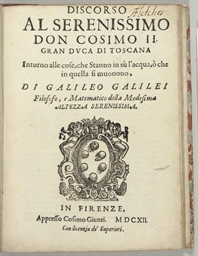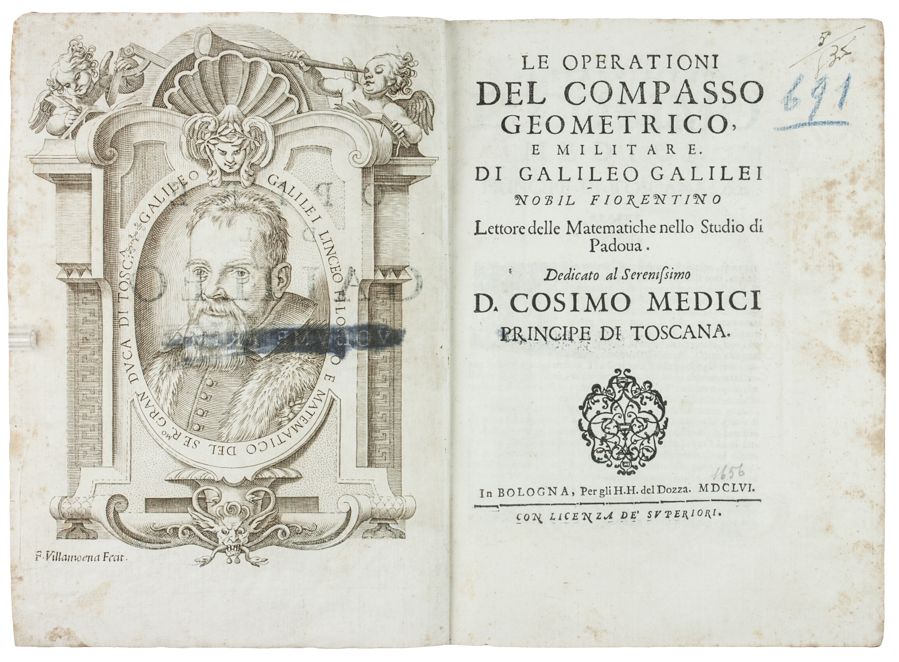GALILEI, Galileo (1564-1642). Discorso al serenissimo Don Cosimo Il Gran Duca di Toscana, intorno alle cose, che stanno in s l'acqua, che in quella si muovono . Florence: Cosimo Giunti, 1612. 4 o (208 x 154 mm). Italic type, revised passages in roman type, woodcut of Medici arms on title, 15 woodcut text diagrams, printer's large woodcut device on recto of last leaf, woodcut initials. (Scattered light foxing.) Contemporary limp vellum. Second edition, extensively augmented, of Galileo's treatise on the properties of bodies in water. In 1611 "Galileo became involved in a controversy over floating bodies... Maffeo Barberini--then a cardinal but later to become pope--took Galileo's side in the dispute" (DSB). In the treatise that he composed on the subject Galileo proved the Archimidean principle that a solid body's ability to float is a function of the relative densities of the object and the fluid, disproving Aristotle's erroneous supposition that the shape of the object was the deciding factor. He showed furthermore that pressure is transmitted through the whole mass of a fluid. "Using the concept of moment and the principle of virtual velocities, Galileo extended the scope of the Archimedean work beyond purely hydrostatic considerations" (DSB). The first edition was published earlier the same year. Giunta explains in his preface that the great demand for the work inspired him to print a second edition, and that the author decided to take advantage of the occasion to expand upon certain passages that he deemed unclear, without going to the trouble of a total revision of the existing text. In order to permit the reader to distinguish the additional material, the new passages are printed in a different typeface. Assailed by criticism for this attack on Aristotelian authority, Galileo published a reply to his critics in 1615, under the name of his pupil and colleague Benedetto Castelli, in which he enlarged upon his scientific argument and presented a vigorous philosophical defense of his position. Carli and Favaro 48; Cinti 35; Norman 856. [ With :] [GALILEI]. PRETE, Sesto. Galileo's letter about the libration of the moon. A critical study, transcription, and translation . New York: John F. Fleming, 1965. (324 x 230 mm). 7-page photographic facsimile of Galileo's autograph letter. Publisher's wrappers. Provenance : PRESENTATION COPY from John Fleming and Harrison Horblit to Haskell Norman (their inscriptions on half-title). Norman 860. (2)
GALILEI, Galileo (1564-1642). Discorso al serenissimo Don Cosimo Il Gran Duca di Toscana, intorno alle cose, che stanno in s l'acqua, che in quella si muovono . Florence: Cosimo Giunti, 1612. 4 o (208 x 154 mm). Italic type, revised passages in roman type, woodcut of Medici arms on title, 15 woodcut text diagrams, printer's large woodcut device on recto of last leaf, woodcut initials. (Scattered light foxing.) Contemporary limp vellum. Second edition, extensively augmented, of Galileo's treatise on the properties of bodies in water. In 1611 "Galileo became involved in a controversy over floating bodies... Maffeo Barberini--then a cardinal but later to become pope--took Galileo's side in the dispute" (DSB). In the treatise that he composed on the subject Galileo proved the Archimidean principle that a solid body's ability to float is a function of the relative densities of the object and the fluid, disproving Aristotle's erroneous supposition that the shape of the object was the deciding factor. He showed furthermore that pressure is transmitted through the whole mass of a fluid. "Using the concept of moment and the principle of virtual velocities, Galileo extended the scope of the Archimedean work beyond purely hydrostatic considerations" (DSB). The first edition was published earlier the same year. Giunta explains in his preface that the great demand for the work inspired him to print a second edition, and that the author decided to take advantage of the occasion to expand upon certain passages that he deemed unclear, without going to the trouble of a total revision of the existing text. In order to permit the reader to distinguish the additional material, the new passages are printed in a different typeface. Assailed by criticism for this attack on Aristotelian authority, Galileo published a reply to his critics in 1615, under the name of his pupil and colleague Benedetto Castelli, in which he enlarged upon his scientific argument and presented a vigorous philosophical defense of his position. Carli and Favaro 48; Cinti 35; Norman 856. [ With :] [GALILEI]. PRETE, Sesto. Galileo's letter about the libration of the moon. A critical study, transcription, and translation . New York: John F. Fleming, 1965. (324 x 230 mm). 7-page photographic facsimile of Galileo's autograph letter. Publisher's wrappers. Provenance : PRESENTATION COPY from John Fleming and Harrison Horblit to Haskell Norman (their inscriptions on half-title). Norman 860. (2)






.jpg)




Try LotSearch and its premium features for 7 days - without any costs!
Be notified automatically about new items in upcoming auctions.
Create an alert